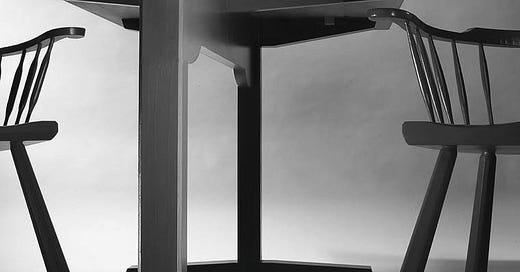Publisher’s note: Happy Saturday, happy Earlywood, a free weekly excerpt from one of the thousands of pieces I’ve written since 1996. Sometimes, it’s from a magazine article. Or a book. Or (in this case) a blog post published in 2006. Each entry has been updated or annotated with some modern context or point of view. Enjoy!
One of my favorite movies as a teenager had a scene where a 1940s-era G-man goes to a mystic for help in becoming a superhero. The G-man shows the mystic, named Sombra, a photo of a caped hero and asks for a magic word to become like him.
Without hesitation, Sombra says: “I suggest you dye your underwear and learn to live within your limitations.” And that, dear reader, is exactly how I felt nearly 20 years ago as I was finishing up the first prototype for an issue of Woodworking Magazine.
The project was a classic American trestle table with traditional joinery. And despite the fact that there was nothing “new” about any aspect of this project, it kicked my butt up one side of the shop and down the other. Fitting the through-tenons in the base took more fussing and fitting than was acceptable, and I still had to patch one side of a joint despite a careful fit. The breadboard ends on the top fit perfectly when dry-fit, but after they were pegged, they each moved off the shoulder line enough that I disassembled the whole end and started over.
Those mistakes seemed unavoidable. And then there were the ones where I was overcome by hubris, the worst shop mistakes possible. I got a little cocky when I drawbored the center of one breadboard in an effort to get a seamless joint line. After all my success at drawboring the base (made of Southern yellow pine) I used the same heavy offset in the black cherry top.
That’s when the entire breadboard end piece exploded in my hands (I, however, had made an extra breadboard for test cuts, which saved me).
And when I completed the two-board top using some locally cut 18"-wide boards that had been drying in my basement, I used a smoothing plane alone to finish the top. No sandpaper. It looked good until I put the first coat of varnish on. Groan. Out with the sandpaper to blend the toolmarks and remove some localized tear-out.
The point here is that even the simplest operations can be a challenge when you change one fact. In this project, it was the scale of everything. It’s one thing to fit a cabinet-scale wedged through-tenon. It’s quite another when the tenon is 1" thick, 3-1/2" wide and 3" long. Same goes with the breadboard and the top itself. Fitting a tenon’s shoulder that’s 3" across is easy compared to a breadboard shoulder that’s 30" across. There is a lot less room for error.
But with the table complete, I took stock of the project and concluded that this trestle table and its joinery were an outstanding lesson in traditional joints. It taught one of the most important and forgotten joinery techniques around, wedging. I’ve wedged tens of thousands of through-tenons, but that’s because I’ve been deeply into chairmaking for many years now, and a single chair can have 25 to 30 wedged joints (depending on how nuts you are; I am fairly nuts).
Once that first table was complete, I knew exactly how to modify my stock techniques to make assembly easier in the future.
But at the time, I also wondered if I should just go to Kroger and get some black vegetable dye for my underwear. It could have been the hubris talking.
Editor’s update, 2025…though it’s really a 2023 update. If memory serves, the table shown above was donated to White Water Shaker Village, a Shaker site to the northwest of Cincinnati.
Chris also built a trestle table for his family at around the same time, and it taught him another lesson, this time about finish. The top was sprayed with lacquer, which looked fabulous for a day, maybe two. Then some nail polish remover was spilled on it, and for a decade, it needed refinishing. We finally got around to that in 2023. You can read more about it here, but in short, we sanded off the lacquer and refinished it with soft wax.





It wasn't hubris that doomed Icarus, it was using crappy glue.
I'm working on my "Forever" workbench -- Holtzapffel), and it's great practice in living with my own humanity. (Especially the well repaired hole in the front where I mistakenly measured the wrong distance for a vice screw.) I've decided just this morning, that that patch will be an excellent reminder to not only measure twice, but to consult the plans at least once.